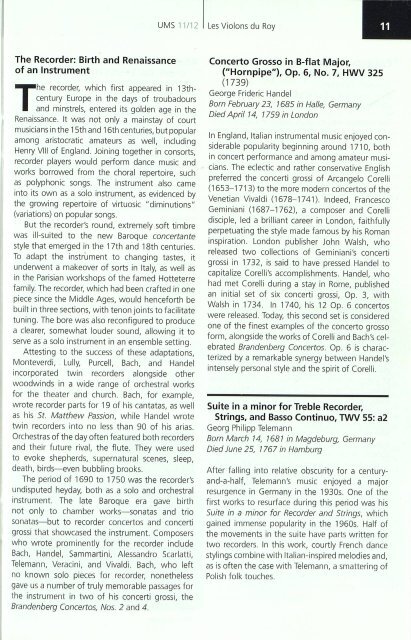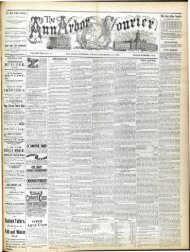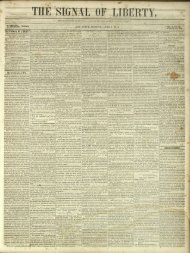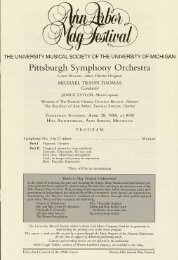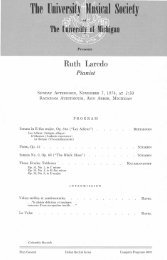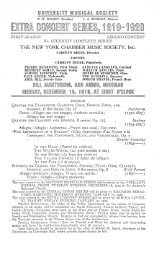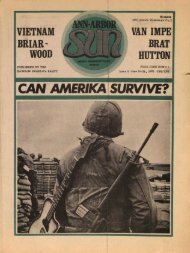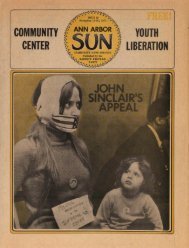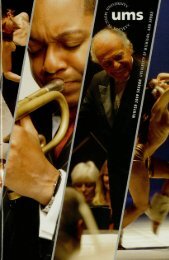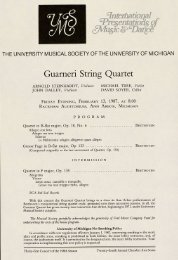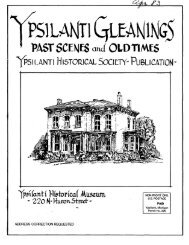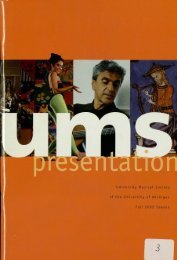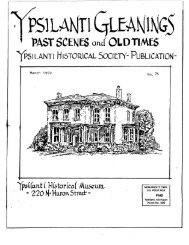University Musical Society - Ann Arbor District Library
University Musical Society - Ann Arbor District Library
University Musical Society - Ann Arbor District Library
You also want an ePaper? Increase the reach of your titles
YUMPU automatically turns print PDFs into web optimized ePapers that Google loves.
The Recorder: Birth and Renaissance<br />
of an Instrument<br />
The recorder, which first appeared in 13th-<br />
century Europe in the days of troubadours<br />
and minstrels, entered its golden age in the<br />
Renaissance. It was not only a mainstay of court<br />
musicians in the 15th and 16th centuries, but popular<br />
among aristocratic amateurs as well, including<br />
Henry VIII of England. Joining together in consorts,<br />
recorder players would perform dance music and<br />
works borrowed from the choral repertoire, such<br />
as polyphonic songs. The instrument also came<br />
into its own as a solo instrument, as evidenced by<br />
the growing repertoire of virtuosic "diminutions"<br />
(variations) on popular songs.<br />
But the recorder's round, extremely soft timbre<br />
was ill-suited to the new Baroque concertante<br />
style that emerged in the 17th and 18th centuries.<br />
To adapt the instrument to changing tastes, it<br />
underwent a makeover of sorts in Italy, as well as<br />
in the Parisian workshops of the famed Hotteterre<br />
family. The recorder, which had been crafted in one<br />
piece since the Middle Ages, would henceforth be<br />
built in three sections, with tenon joints to facilitate<br />
tuning. The bore was also reconfigured to produce<br />
a clearer, somewhat louder sound, allowing it to<br />
serve as a solo instrument in an ensemble setting.<br />
Attesting to the success of these adaptations,<br />
Monteverdi, Lully, Purcell, Bach, and Handel<br />
incorporated twin recorders alongside other<br />
woodwinds in a wide range of orchestral works<br />
for the theater and church. Bach, for example,<br />
wrote recorder parts for 19 of his cantatas, as well<br />
as his St. Matthew Passion, while Handel wrote<br />
twin recorders into no less than 90 of his arias.<br />
Orchestras of the day often featured both recorders<br />
and their future rival, the flute. They were used<br />
to evoke shepherds, supernatural scenes, sleep,<br />
death, birds—even bubbling brooks.<br />
The period of 1690 to 1750 was the recorder's<br />
undisputed heyday, both as a solo and orchestral<br />
instrument. The late Baroque era gave birth<br />
not only to chamber works—sonatas and trio<br />
sonatas—but to recorder concertos and concert!<br />
gross! that showcased the instrument. Composers<br />
who wrote prominently for the recorder include<br />
Bach, Handel, Sammartini, Alessandro Scarlatti,<br />
Telemann, Veracini, and Vivaldi. Bach, who left<br />
no known solo pieces for recorder, nonetheless<br />
gave us a number of truly memorable passages for<br />
the instrument in two of his concert! grossi, the<br />
Brandenberg Concertos, Nos. 2 and 4.<br />
UMS Les Violons du Roy<br />
Concerto Grosso in B-flat Major,<br />
("Hornpipe"), Op. 6, No. 7, HWV 325<br />
(1739)<br />
George Frideric Handel<br />
Born February 23, 1685 in Halle, Germany<br />
Died April 14, 1759 in London<br />
In England, Italian instrumental music enjoyed con<br />
siderable popularity beginning around 1710, both<br />
in concert performance and among amateur musi<br />
cians. The eclectic and rather conservative English<br />
preferred the concert! grossi of Arcangelo Corelli<br />
(1653-1713) to the more modern concertos of the<br />
Venetian Vivaldi (1678-1741). Indeed, Francesco<br />
Geminiani (1687-1762), a composer and Corelli<br />
disciple, led a brilliant career in London, faithfully<br />
perpetuating the style made famous by his Roman<br />
inspiration. London publisher John Walsh, who<br />
released two collections of Geminiani's concert!<br />
grossi in 1732, is said to have pressed Handel to<br />
capitalize Corelli's accomplishments. Handel, who<br />
had met Corelli during a stay in Rome, published<br />
an initial set of six concert! grossi. Op. 3, with<br />
Walsh in 1734. In 1740, his 12 Op. 6 concertos<br />
were released. Today, this second set is considered<br />
one of the finest examples of the concerto grosso<br />
form, alongside the works of Corelli and Bach's cel<br />
ebrated Brandenberg Concertos. Op. 6 is charac<br />
terized by a remarkable synergy between Handel's<br />
intensely personal style and the spirit of Corelli.<br />
Suite in a minor for Treble Recorder,<br />
Strings, and Basso Continue, TWV 55: a2<br />
Georg Philipp Telemann<br />
Born March 14, 1681 in Magdeburg, Germany<br />
Died June 25, 1767 in Hamburg<br />
After falling into relative obscurity for a century-<br />
and-a-half, Telemann's music enjoyed a major<br />
resurgence in Germany in the 1930s. One of the<br />
first works to resurface during this period was his<br />
Suite in a minor for Recorder and Strings, which<br />
gained immense popularity in the 1960s. Half of<br />
the movements in the suite have parts written for<br />
two recorders. In this work, courtly French dance<br />
stylings combine with Italian-inspired melodies and,<br />
as is often the case with Telemann, a smattering of<br />
Polish folk touches.


